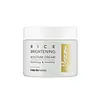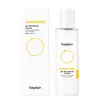What's inside
What's inside
 Key Ingredients
Key Ingredients

 Benefits
Benefits

 Concerns
Concerns

No concerns
 Ingredients Side-by-side
Ingredients Side-by-side

Water
Skin ConditioningOryza Sativa Extract
AbsorbentGlycerin
Humectant1,2-Hexanediol
Skin ConditioningNiacinamide
SmoothingMethylpropanediol
SolventCentella Asiatica Extract
CleansingCamellia Sinensis Leaf Extract
AntimicrobialEclipta Prostrata Leaf Extract
Skin ConditioningPhellodendron Amurense Bark Extract
Skin ConditioningAcmella Oleracea Extract
Skin ProtectingFicus Carica Fruit Extract
HumectantLaminaria Japonica Extract
Skin ProtectingLeucojum Aestivum Bulb Extract
Skin ProtectingCeramide NP
Skin ConditioningHydrogenated Lecithin
EmulsifyingBeta-Glucan
Skin ConditioningHydrolyzed Hyaluronic Acid
HumectantGlyceryl Polymethacrylate
Octyldodeceth-16
EmulsifyingAmmonium Acryloyldimethyltaurate/Vp Copolymer
Acrylates/C10-30 Alkyl Acrylate Crosspolymer
Emulsion StabilisingFructooligosaccharides
HumectantDisodium EDTA
Ethylhexylglycerin
Skin ConditioningCellulose Gum
Emulsion StabilisingWater, Oryza Sativa Extract, Glycerin, 1,2-Hexanediol, Niacinamide, Methylpropanediol, Centella Asiatica Extract, Camellia Sinensis Leaf Extract, Eclipta Prostrata Leaf Extract, Phellodendron Amurense Bark Extract, Acmella Oleracea Extract, Ficus Carica Fruit Extract, Laminaria Japonica Extract, Leucojum Aestivum Bulb Extract, Ceramide NP, Hydrogenated Lecithin, Beta-Glucan, Hydrolyzed Hyaluronic Acid, Glyceryl Polymethacrylate, Octyldodeceth-16, Ammonium Acryloyldimethyltaurate/Vp Copolymer, Acrylates/C10-30 Alkyl Acrylate Crosspolymer, Fructooligosaccharides, Disodium EDTA, Ethylhexylglycerin, Cellulose Gum
Anthemis Nobilis Flower Extract 71.06%
MaskingGlycerin
HumectantCaprylic/Capric Triglyceride
MaskingEthylhexyl Stearate
EmollientPolyglyceryl-3 Methylglucose Distearate
Emulsifying1,2-Hexanediol
Skin ConditioningEclipta Prostrata Leaf Extract
Skin ConditioningLaminaria Japonica Extract
Skin ProtectingWater
Skin ConditioningSodium Stearoyl Glutamate
CleansingAmmonium Acryloyldimethyltaurate/Beheneth-25 Methacrylate Crosspolymer
Emulsion StabilisingAmmonium Acryloyldimethyltaurate/Vp Copolymer
Centella Asiatica Extract
CleansingFicus Carica Fruit Extract
HumectantEthylhexylglycerin
Skin ConditioningAcmella Oleracea Extract
Skin ProtectingButylene Glycol
HumectantSqualane
EmollientSodium Hyaluronate
HumectantCitric Acid
BufferingDisodium EDTA
Fructooligosaccharides
HumectantHydrogenated Lecithin
EmulsifyingAllantoin
Skin ConditioningBeta-Glucan
Skin ConditioningCamellia Japonica Seed Oil
EmollientMacadamia Integrifolia Seed Oil
Skin ConditioningAmaranthus Caudatus Seed Extract
Skin ConditioningUlmus Davidiana Root Extract
Skin ConditioningHydrolyzed Hyaluronic Acid
HumectantPentylene Glycol
Skin ConditioningCeramide NP
Skin ConditioningSodium Hyaluronate Crosspolymer
HumectantHyaluronic Acid
HumectantHydrolyzed Sodium Hyaluronate
Skin ConditioningAnthemis Nobilis Flower Extract 71.06%, Glycerin, Caprylic/Capric Triglyceride, Ethylhexyl Stearate, Polyglyceryl-3 Methylglucose Distearate, 1,2-Hexanediol, Eclipta Prostrata Leaf Extract, Laminaria Japonica Extract, Water, Sodium Stearoyl Glutamate, Ammonium Acryloyldimethyltaurate/Beheneth-25 Methacrylate Crosspolymer, Ammonium Acryloyldimethyltaurate/Vp Copolymer, Centella Asiatica Extract, Ficus Carica Fruit Extract, Ethylhexylglycerin, Acmella Oleracea Extract, Butylene Glycol, Squalane, Sodium Hyaluronate, Citric Acid, Disodium EDTA, Fructooligosaccharides, Hydrogenated Lecithin, Allantoin, Beta-Glucan, Camellia Japonica Seed Oil, Macadamia Integrifolia Seed Oil, Amaranthus Caudatus Seed Extract, Ulmus Davidiana Root Extract, Hydrolyzed Hyaluronic Acid, Pentylene Glycol, Ceramide NP, Sodium Hyaluronate Crosspolymer, Hyaluronic Acid, Hydrolyzed Sodium Hyaluronate
Ingredients Explained
These ingredients are found in both products.
Ingredients higher up in an ingredient list are typically present in a larger amount.
1,2-Hexanediol is a synthetic liquid and another multi-functional powerhouse.
It is a:
- Humectant, drawing moisture into the skin
- Emollient, helping to soften skin
- Solvent, dispersing and stabilizing formulas
- Preservative booster, enhancing the antimicrobial activity of other preservatives
We don't have a description for Acmella Oleracea Extract yet.
Ammonium Acryloyldimethyltaurate/Vp Copolymer (let's call it AAVC for short) is a synthetically created polymer. It's used as a film-forming agent and used to thicken the consistency of products.
AAVC is able to increase the consistency and viscosity of products due to its large molecule size. It also prevents ingredients from separating.
Beta-Glucan is a polysaccharide. It can be derived from the cell walls of seaweed, oats, yeast, and fungi. It hydrates the skin and helps boost your skin's natural barrier.
As an antioxidant, beta-glucan helps fight free-radicals. Free-radicals are molecules that may damage your skin cells, such as pollution.
Studies show this ingredient may be an effective wrinkle reducer as it can deeply penetrate into skin. It has also been show to help with wound healing.
Learn more about Beta-GlucanCentella Asiatica Extract (Centella) is derived from an herb native to Southeast Asia. It is famous for its anti-inflammatory and soothing properties.
Centella is rich in antioxidants and amino acids, such as Madecassic Acid and Asiaticoside.
Studies show the compounds in centella help with:
The combination of all these properties makes centella effective at soothing, hydrating, and protecting the skin.
Other great components of centella include Vitamin A, vitamin C, several B vitamins, and Asiatic Acid.
Fun fact: Centella has been used as a medicine and in food for many centuries. As a medicine, it is used to treat burns, scratches, and wounds.
Learn more about Centella Asiatica ExtractCeramide NP is a type of ceramide and formally known as ceramide 3.
Ceramides are intercellular lipids naturally found in our skin that bonds dead skin cells together to create a barrier. They are known for their ability to hold water and thus are a great ingredient for dry skin.
Ceramides are an important building block for our skin barrier. A stronger barrier helps the skin look more firm and hydrated. By bolstering the skin ceramides act as a barrier against irritating ingredients. This can help with inflammation as well.
If you would like to eat ceramides, sweet potatoes contain a small amount.
Read more about other common types of ceramides here:
Ceramide AP
Ceramide EOP
Disodium EDTA plays a role in making products more stable by aiding other preservatives.
It is a chelating agent, meaning it neutralizes metal ions that may be found in a product.
Disodium EDTA is a salt of edetic acid and is found to be safe in cosmetic ingredients.
Learn more about Disodium EDTAEclipta Prostrata Leaf Extract comes from the false daisy plant. False daisy contains antioxidant compounds such as flavonoids.
One study found false daisy to absorb UVA and UVB radiation. However, this should not replace your sunscreen.
False daisy is used in both traditional medicines and foods throughout Southeast Asia and India.
Learn more about Eclipta Prostrata Leaf ExtractEthylhexylglycerin (we can't pronounce this either) is commonly used as a preservative and skin softener. It is derived from glyceryl.
You might see Ethylhexylglycerin often paired with other preservatives such as phenoxyethanol. Ethylhexylglycerin has been found to increase the effectiveness of these other preservatives.
Ficus Carica Fruit Extract comes from the fruit known as the fig. Figs are rich in antioxidants and helps hydrate the skin.
Figs also contain fatty acids and Vitamins A, B1, and B2.
As a humectant, figs are able to draw moisture from the air to your skin. This helps keep your skin hydrated.
Learn more about Ficus Carica Fruit ExtractFructooligosaccharides is an alternative sweetener. It is often derived from the blue agave plant.
This ingredient is a prebiotic and helps to hydrate the skin. Emerging studies are also showing fructooligosaccharides to have antioxidant properties.
As a humectant, Fructooligosaccharides helps draw moisture to the skin, helping to hydrate the skin.
Bananas, onions, garlic, asparagus, jícama, and leeks also contain fructooligosaccharides.
Learn more about FructooligosaccharidesGlycerin is already naturally found in your skin. It helps moisturize and protect your skin.
A study from 2016 found glycerin to be more effective as a humectant than AHAs and hyaluronic acid.
As a humectant, it helps the skin stay hydrated by pulling moisture to your skin. The low molecular weight of glycerin allows it to pull moisture into the deeper layers of your skin.
Hydrated skin improves your skin barrier; Your skin barrier helps protect against irritants and bacteria.
Glycerin has also been found to have antimicrobial and antiviral properties. Due to these properties, glycerin is often used in wound and burn treatments.
In cosmetics, glycerin is usually derived from plants such as soybean or palm. However, it can also be sourced from animals, such as tallow or animal fat.
This ingredient is organic, colorless, odorless, and non-toxic.
Glycerin is the name for this ingredient in American English. British English uses Glycerol/Glycerine.
Learn more about GlycerinHydrogenated Lecithin is created from the hydrogenation of lecithin (a group of phospholipids). Hydrogenation is a chemical reaction between hydrogen and another element.
This ingredient is an emollient and emulsifier. As an emollient, it helps soften skin by trapping moisture within. As an emulsifier, it prevents oil and water ingredients from separating.
Hydrolyzed Hyaluronic Acid is a form of hyaluronic acid. It is created by the hydrolysis of hyaluronic acid with a high molecular weight. Once created, Hydrolyzed Hyaluronic Acid has a low molecular weight.
Low molecular weight HA has been shown to hydrate and increase elasticity of the skin. Increasing elasticity is also associated with reduction of wrinkle depth.
One study found topical low molecular weight hyaluronic acid may be considered for the treatment of rosacea in the adult population. However, we always recommend speaking with a professional about your skin concerns.
Hyaluronic acids are a humectant. This means they draw moisture from the air. Hyaluronic acids help moisturize, soothe, and protect the skin.
Read more about other common forms of hyaluronic acid:
Learn more about Hydrolyzed Hyaluronic AcidLaminaria Japonica Extract comes from a kelp more commonly known as 'sweet kelp'. It is commonly eaten in Japan, Korea, and China.
Sweet kelp is a humectant and helps hydrate your skin. Humectants draw moisture from the air to your skin.
Studies show Laminaria Japonica has antioxidant compounds. Antioxidants may help with anti-aging. Kelp also contains magnesium and zinc, making it great for calming inflammation and redness.
Learn more about Laminaria Japonica ExtractWater. It's the most common cosmetic ingredient of all. You'll usually see it at the top of ingredient lists, meaning that it makes up the largest part of the product.
So why is it so popular? Water most often acts as a solvent - this means that it helps dissolve other ingredients into the formulation.
You'll also recognize water as that liquid we all need to stay alive. If you see this, drink a glass of water. Stay hydrated!
Learn more about Water